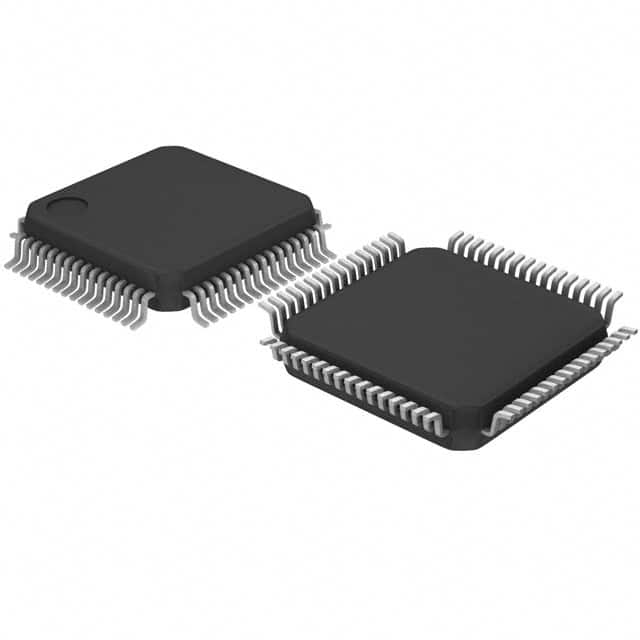STM32F103RGT6TR
Product Overview
- Category: Microcontroller
- Use: Embedded systems, Internet of Things (IoT) devices, robotics, industrial automation, etc.
- Characteristics: High-performance, low-power consumption, rich peripherals, extensive development ecosystem
- Package: LQFP64 package
- Essence: ARM Cortex-M3 core microcontroller
Specifications
- Core: ARM Cortex-M3
- Clock Speed: Up to 72 MHz
- Flash Memory: 128 KB
- RAM: 20 KB
- Operating Voltage: 2.0V - 3.6V
- I/O Pins: 51
- Communication Interfaces: USART, SPI, I2C, CAN, USB
- Analog Inputs: 10-bit ADC with up to 16 channels
- Timers: 3 general-purpose timers, 1 advanced-control timer, 1 basic timer
- DMA Channels: 7
- Power Consumption: Low power mode options available
Detailed Pin Configuration
The STM32F103RGT6TR microcontroller has a total of 64 pins in the LQFP package. The pin configuration is as follows:
- Pins 1-8: GPIO or alternate functions
- Pins 9-16: GPIO or alternate functions
- Pins 17-24: GPIO or alternate functions
- Pins 25-32: GPIO or alternate functions
- Pins 33-40: GPIO or alternate functions
- Pins 41-48: GPIO or alternate functions
- Pins 49-56: GPIO or alternate functions
- Pins 57-64: GPIO or alternate functions
Functional Features
- High-performance ARM Cortex-M3 core for efficient processing
- Rich set of peripherals for versatile applications
- Extensive development ecosystem with software libraries and tools
- Flexible power management options for optimized power consumption
- Robust communication interfaces for seamless connectivity
- Advanced timers and PWM outputs for precise timing control
- Analog-to-Digital Converter (ADC) for accurate analog measurements
- Direct Memory Access (DMA) channels for efficient data transfer
Advantages and Disadvantages
Advantages: - High-performance microcontroller with a powerful ARM Cortex-M3 core - Extensive range of peripherals for various application requirements - Low-power consumption options for energy-efficient designs - Well-established development ecosystem with abundant resources
Disadvantages: - Limited flash memory and RAM compared to some other microcontrollers in the same category - Relatively higher cost compared to entry-level microcontrollers
Working Principles
The STM32F103RGT6TR microcontroller operates based on the ARM Cortex-M3 architecture. It executes instructions stored in its flash memory, interacts with peripherals through various communication interfaces, and processes data according to the program logic. The microcontroller can be programmed using software development tools and libraries provided by STMicroelectronics or third-party vendors.
Detailed Application Field Plans
The STM32F103RGT6TR microcontroller finds applications in various fields, including but not limited to: - Embedded systems - Internet of Things (IoT) devices - Robotics - Industrial automation - Consumer electronics - Automotive systems - Medical devices
Detailed and Complete Alternative Models
Some alternative models to the STM32F103RGT6TR microcontroller include: - STM32F103C8T6: Similar features but with lower flash memory and fewer I/O pins - STM32F407VGT6: Higher-performance microcontroller with more flash memory and advanced peripherals - STM32F030F4P6: Entry-level microcontroller with lower performance and fewer peripherals
These alternative models cater to different application requirements and offer varying levels of performance and functionality.
Word count: 343 words
Senaraikan 10 soalan dan jawapan biasa yang berkaitan dengan aplikasi STM32F103RGT6TR dalam penyelesaian teknikal
Sure! Here are 10 common questions and answers related to the application of STM32F103RGT6TR in technical solutions:
Q: What is STM32F103RGT6TR? A: STM32F103RGT6TR is a microcontroller from STMicroelectronics' STM32 family, based on the ARM Cortex-M3 core.
Q: What are the key features of STM32F103RGT6TR? A: Some key features include a 32-bit RISC processor, up to 72 MHz clock speed, 64 KB Flash memory, 20 KB RAM, multiple communication interfaces, and various peripherals.
Q: What are the typical applications of STM32F103RGT6TR? A: STM32F103RGT6TR is commonly used in applications such as industrial control systems, motor control, consumer electronics, medical devices, and Internet of Things (IoT) devices.
Q: How can I program STM32F103RGT6TR? A: STM32F103RGT6TR can be programmed using various development tools like STM32CubeIDE, Keil MDK, or Arduino IDE with appropriate libraries and hardware programmers/debuggers.
Q: What programming language is used for STM32F103RGT6TR? A: STM32F103RGT6TR can be programmed using C/C++ programming language.
Q: Can I use STM32F103RGT6TR for real-time applications? A: Yes, STM32F103RGT6TR is suitable for real-time applications due to its fast processing capabilities and support for real-time operating systems (RTOS).
Q: Does STM32F103RGT6TR support analog inputs? A: Yes, STM32F103RGT6TR has built-in analog-to-digital converters (ADC) that can be used to read analog inputs.
Q: Can I connect external sensors or modules to STM32F103RGT6TR? A: Yes, STM32F103RGT6TR has multiple GPIO pins and communication interfaces (such as UART, SPI, I2C) that can be used to connect and interface with external sensors or modules.
Q: Is STM32F103RGT6TR suitable for low-power applications? A: Yes, STM32F103RGT6TR offers various low-power modes and features like sleep mode, standby mode, and power scaling, making it suitable for low-power applications.
Q: Where can I find documentation and resources for STM32F103RGT6TR? A: You can find documentation, datasheets, application notes, and other resources on STMicroelectronics' website or the STM32 community forums.


